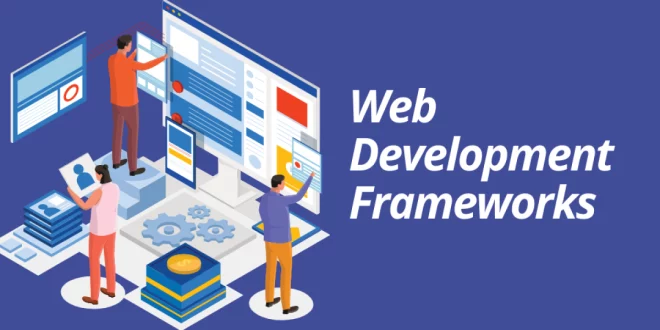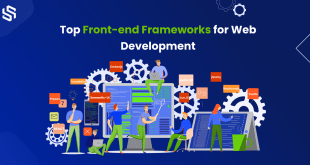In today’s rapidly evolving digital landscape, web development is experiencing a revolution like never before. As technology advances, frontend frameworks play a pivotal role in shaping the user experience and driving innovation. In this comprehensive guide, we’ll delve into the latest frontend frameworks of 2023, with a particular focus on React.js. Prepare to be amazed as we unravel the power of these cutting-edge tools and how they are transforming the way we build dynamic and interactive web applications.
The Evolution of Frontend Frameworks
Frontend frameworks have come a long way since the early days of web development. In the past, developers relied on basic HTML, CSS, and JavaScript to create static web pages. However, with the increasing demand for more sophisticated and interactive websites, frontend frameworks emerged to streamline the development process and enhance user experiences. Today, these frameworks provide a robust foundation for building complex applications with ease.
Introducing React.js: The Revolutionary Player
At the forefront of frontend frameworks is React.js, an open-source JavaScript library maintained by Facebook. React.js has gained immense popularity due to its component-based architecture, which allows developers to build reusable UI elements. This approach not only simplifies code maintenance but also enhances performance by efficiently rendering only the necessary components.
React.js has become the go-to choice for countless web developers, making it essential to gain a thorough understanding of its features and capabilities.
Unraveling the Core Concepts of React.js
Components and JSX
Central to React.js is the concept of components. A component is a self-contained, reusable building block that encapsulates both the UI and the logic. JSX (JavaScript XML) enables developers to write HTML-like code within JavaScript, making it easier to define these components.
Virtual DOM
React.js introduces the Virtual DOM, a lightweight representation of the actual DOM. When changes occur in the application, React.js efficiently updates only the necessary components in the Virtual DOM, reducing rendering time and improving overall performance.
State and Props
State and props are fundamental in React.js. State represents the mutable data specific to a component, while props are immutable data passed from parent to child components. Understanding how to manage state and props is crucial for building dynamic applications.
The Power of React Tutorials
Learning React.js can be a transformative experience for aspiring web developers. Numerous online tutorials provide step-by-step guidance to grasp the ins and outs of React.js effectively. These tutorials not only cover the basics but also dive into advanced topics like state management, hooks, and context API.
Embracing the Frontend Ecosystem
While React.js stands as a dominant player, the frontend ecosystem is filled with a diverse array of frameworks, each with its unique strengths. Developers must explore other popular frameworks like Angular, Vue.js, and Svelte to identify the best fit for their projects. Diversifying expertise can lead to more versatile and adaptable development approaches.
Key Factors in Choosing the Right Framework
When choosing a frontend framework, several factors must be considered:
Community Support: A thriving community ensures continuous updates, bug fixes, and access to a wealth of knowledge.
Performance: Evaluate how the framework optimizes performance and handles rendering to ensure a smooth user experience.
Learning Curve: Consider the complexity of the framework and the available learning resources.
Scalability: Determine if the framework can accommodate the growth of the application without compromising performance.
7. Leveraging the Latest Features of Frontend Frameworks
In 2023, frontend frameworks are evolving rapidly, introducing new features and enhancements. Some notable features include:
Server-Side Rendering (SSR): SSR improves initial page loading time and SEO, enhancing user experience and search engine rankings.
Progressive Web Apps (PWAs): PWAs bring native app-like experiences to web applications, boosting engagement and accessibility.
WebAssembly (Wasm): Wasm empowers developers to execute high-performance code across different platforms, unlocking new possibilities.
Overcoming Challenges in Frontend Development
Frontend development has its fair share of challenges, such as:
Cross-Browser Compatibility: Ensuring consistent behavior across various browsers can be demanding.
Responsive Design: Designing interfaces that adapt seamlessly to different screen sizes and devices is crucial for user satisfaction.
Security: Implementing robust security measures to protect user data and prevent vulnerabilities.
The Future of Frontend Development
The future of frontend development holds endless possibilities. As technology continues to advance, we can expect frameworks to become even more powerful, flexible, and intuitive. Real-time collaboration, AI integration, and voice-controlled interfaces are just a few exciting prospects on the horizon.
Final Words
Frontend frameworks, led by React.js, are revolutionizing web development in 2023. Understanding the core concepts, exploring tutorials, and embracing the frontend ecosystem will empower developers to build dynamic and cutting-edge applications. By leveraging the latest features and overcoming challenges, the future of frontend development is bright and full of endless opportunities.
Frequently Asked Questions
Q1: Is React.js suitable for large-scale applications?
A1: Absolutely! React.js is highly scalable and is used in many large-scale applications, including Facebook itself. Its Virtual DOM and efficient rendering ensure excellent performance even in complex projects.
Q2: What makes React.js different from other frontend frameworks?
A2: React.js stands out with its component-based architecture and JSX, enabling developers to create reusable UI elements with ease. Its strong community support and focus on performance make it a popular choice.
Q3: Are there any disadvantages to using frontend frameworks?
A3: While frontend frameworks offer numerous benefits, they can introduce a learning curve, and some frameworks may have a steeper one than others. Additionally, overuse of certain features might lead to performance issues.
Q4: How can I keep up with the rapid changes in frontend development?
A4: Staying up-to-date with the latest trends and attending web development conferences can help you stay informed about the evolving landscape.
Q5: What is the significance of PWAs in modern web development?
A5: Progressive Web Apps combine the best of web and native apps, offering a seamless user experience, offline capabilities, and enhanced performance. They are crucial for engaging and retaining users.
 webfily
webfily



